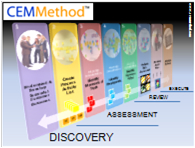Economics of the 18th century won’t help now. Growing revenues through client acquisition and increasing product complexity can no longer sustain growth.
Promiscuous
Customers have become promiscuous and see little to encourage them to stay with one vendor rather than another. In fact many customer relationships are so poor customers actively seek and acquire alternatives.
Customer churn is at an all-time high. In 2010 across Germany a remarkable 42% of customers have been with their bank less than 12 months (source: Mentor). And yet customer acquisition costs in banking have increased so much that insurers need to retain their clients for 6-7 years just to break even.
Prosumer
Customers have become sophisticated, informed and choosey. Often times knowing more about the product and service they wish to buy than the people selling the products in the first place. Think about the cellular phone experience. We know what we want, the tariff, the contract, the precise number of texts per month, the connectedness (wi-fi, 4G etc.). And meanwhile the hapless sales associate can only hope to skim the surface of our needs with daily briefings and headlines for new products. Customers can even fall victim to clipboard man. The guy in the store who wants to sequence customer interactions through various sales reps and keeps you waiting like a piece of assembly on the production line. This inside-out industrial age mind-set doesn’t work with a Prosumer, who votes with their feet to companies who better understand their needs.
Rebellious
Time machine – 1970’s. You have a poor experience and share it with 20 other people. Fast forward 2012. You have a bad experience and you tell twelve million people (United Breaks Guitars, Youtube http://bit.ly/BreaksGuitars). Or even not telling companies why you leave them – why waste your breath?
Successful Customer Outcomes
Customers no longer believe excuses for complexity including data protection, regulatory requirements and sloppy communications. They require organisations to decouple overly complicated procedures and speak in plain English. Promises to deliver should be met without exception. The customer experience has become the process so organisations need to ensure a laser like focus on delivering success customer outcomes, handholding clients through the evaluation and engagement processes. Customers value the resulting intimacy and this in turn becomes a means to build future sales and loyalty. Direct measures of success include simultaneous revenue growth, cost reduction (less leakage and rework) and service improvements.
High Expectations
Making promises is easy — keeping promises is so much harder. It is easier than ever to commit to delivering great service and yet, when the rubber hits the road a car wreck is the usual result. Customers are now fickle and recall poor service with friends across Facebook, twitter and other global social networks. Meanwhile organisations struggle to overcome cross functional fault lines. Mindset myopia locks departments and divisions into divided thinking resulting in fractured customer experiences.
Multi-channel management
25 years ago banks could survive with two channels to market such as postal services and branches. Today the same banks must offer service across multiple channels including ATM, email, text, mail, voice, face to face, and the classic branch and postal service. Customers require these services to be seamless and desire a consistent and comprehensive interaction at all points of contact.
These Moments of Truth need engineering to make customers lives easier, simple and more successful. Furthermore the internal interactions resulting from multi channel contacts need clear articulation and simplifying to an optimum number. For any process that deserves to exist there is an optimum number of Moments of Truth to achieve a successful outcome.
For any business hoping to grow and build the emphasis has shifted from resource management and the development of internal skill sets to understanding and aligning to customer needs. Or as Jeff Bezos, CEO Amazon, says “working backwards” to deliver customer success.
In the next instalment we’ll get onto reviewing the technology changes, which of course go right to the heart of the matter….








